Still life
Table
A Bouquet of Flowers
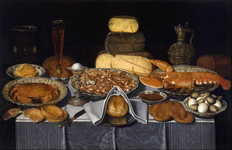
Still Life with Crab, Shrimps and Lobster
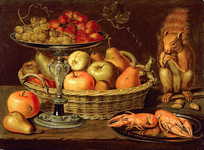
Still life with silver-gilt tazza
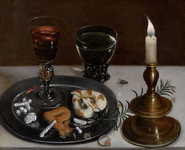
Still Life with Facon de-Venise glass, Römer and a candle
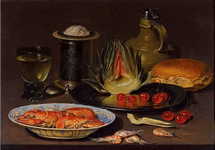
Still Life with artichoke, crab and cherries

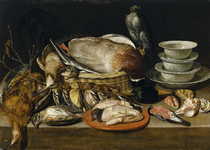
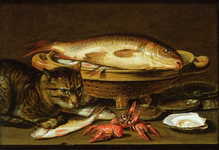
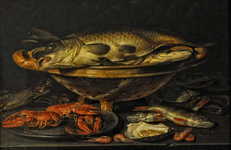
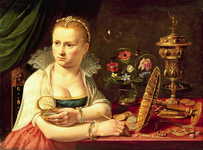
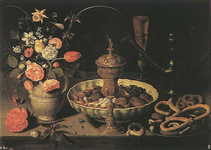
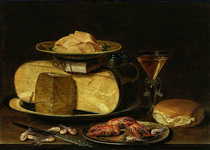

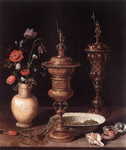
Still-Life with Flowers and Goblets
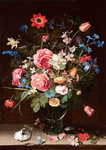
Fine Art Prints | Greeting Cards | Phone Cases | Lifestyle | Face Masks | Men's , Women' Apparel | Home Decor | jigsaw puzzles | Notebooks | Tapestries | ...
Clara Peeters (probably Antwerp 1594 – possibly after 1657) was a still-life painter who came from Antwerp and trained in the tradition of Flemish Baroque painting, but probably made her career mostly in the new Dutch Republic, as part of Dutch Golden Age painting. From dates on her paintings, she was fully active between 1607 and 1621, but after that the picture is less clear, though works were produced until the mid-1630s. Many aspects of her life and work remain very unclear, especially outside the period 1607 to 1621, when she was between 13/14 and 28 years old according to the usual dating.[1] As Seymour Slive puts it "Not a single uncontested document has surfaced about her life but there is reason to believe she was active in both Flanders and Holland."[2]
She was unusual for her time in being a female painter, and is the earliest significant woman painter of the Dutch Golden Age; if regarded as a Flemish painter, she was the most famous woman of the 17th century.[3] Most other female Dutch painters also specialized in still-lifes, which did not require knowledge of anatomy, among other advantages for women. Unlike Maria van Oosterwyck and Rachel Ruysch, who specialized in flower painting, Peeters painted mostly subjects including food, and was prominent among the artists who shaped the traditions of the Dutch ontbijtjes, "breakfast pieces" with plain food and simple vessels, and banketje, "banquet pieces" with expensive cups and vessels in precious metals.[4] More than any other artist, her works often include careful depictions of different types of cheese, still a food taken very seriously by the Dutch.
Life
Still Life with Flowers and Gold Cups of Honor, 1612, with reflections of the artist on the bosses of the cup at right
Little
is known about the life of Clara Peeters. It is traditionally agreed by
scholars that her work appears to indicate she was from Antwerp. The
Antwerp community archives includes a record of a Clara Peeters,
daughter of Jean (Jan) Peeters, baptized on 15 May 1594 in the Church
of St. Walburga.[5] A second document indicates a marriage between
Clara Peeters and Hendrick (Henri) Joosen on 31 May 1639, in the same
church.[6] If she, indeed, is the Clara Peeters of these two documents,
who married Henri Joosen, this would indicate both that her earliest
dated paintings were done when she was 14, and that she was forty-five
years old at her marriage; the average age of brides in the early
modern era was about eighteen.[7]
Although it was unusual to
marry so late, it was not unheard of, especially among female artists.
For example, Sofonisba Anguissola, famous sixteenth-century artist,
married at nearly forty years of age.[8] Some scholars have doubted
that the works of the years from 1607 can have been done by one so
young, and posited that she was perhaps some ten years older.[9]
Some
have suggested that in light of there not being any evident work by
Peeters after the mid-1630s, she ceased painting after her marriage (as
for example Judith Leyster effectively did). She travelled and was
established in Amsterdam by 1611, and is documented in The Hague in
1617.[10] Because of the number of apparent copies of her work by
various hands, some speculate that at some time she headed a small
school of artists.[6] No certificate indicating Peeters' date of death
has been found; however, scholars speculate various dates: 1621; after
1654; after 1657; 1659 and 1676.[6] A painting supposedly by her and
dated 1657 was recorded but is now lost; this is much later than the
dating given to her surviving works.
Training
Still Life with Nuts, Candy and Flowers, 1611, with the artist reflected several times in the metal pieces
Still Life, 1607, signed "CLARA P 1607", also with a P-shaped pretzel
Still Life with Silver-gilt Tazza
Clara’s
first painting, signed and dated 1607, would have been completed when
she was between thirteen and fourteen years of age; the technical
polish and compositional sophistication of this painting and of her
other early works indicate the skill of a highly trained artist.[5] Her
work suggests training in Antwerp, the then artistic capital of the
Netherlands, a city where artists stressed detail and careful finish in
painting.[5]
No record of her apprenticeship has been found.
Most artists as well as apprentices were included in the Artists Guild
listings; however, her name is not found in any of the Artists Guild
lists in Antwerp nor the surrounding areas of Amsterdam, Haarlem,
Delft, Den Hague or Middleburg.[6] Scholars speculate that she may have
been the daughter of a painter, and thus not required to be included in
the apprenticeship listings. Or, perhaps the answer may be in the fact
that the Antwerp Artists’ Guild's lists were lost for the years 1607 to
1628, and some of the names are known only through other documents.[6]
Many
scholars believe her work closely resembles that of Osias Beert and
suppose a relationship between the two; some suggest she was his pupil.
Beert began his career as a still-life painter when he became a master
of the Antwerp guild in 1602;[10] however none of his works are dated,
although some of the copper plates were stamped with dates from 1606 to
1609 by their supplier. Their relationship must remain
speculative.[5][11] She has also been closely aligned with Antwerp
artists Hans Van Essen and Jan Van der Beeck.[12] Jan Bruegel the elder
has also been suggested as a possible teacher.[6]
Although
she was not in its listings, at least one painting of Peeters bears the
stamp of the Antwerp Guild on its back, indicating she was indeed a
member, or at least working on panels made by members of the Antwerp
Guild.[6]
Work
Main article: List of paintings by Clara Peeters
There
is much more information about her works than of her life. Peeters
clearly signed thirty-one works "CLARA PEETERS" or "CLARA P.", and
dated many of them, leaving a strong record of her work from 1607 to
1621.[6] Eighteen of these were completed by the time she was eighteen
years old. In addition, another seventy-six works are speculated to be
in her oeuvre, although documentation is lacking to assign them
affirmatively to Peeters.[6] Several of her paintings, including two
illustrated here, carry the signature represented as an engraved
inscription on the side of the handle of the same decorated knife. The
knife has two nude female figures, no doubt allegorical, on the main
face of the handle that is visible, and is typical of the sort of
"brides knife" (bruidmessen) Antwerp silversmiths produced around
1595-1600. These may represent a real knife owned by Peeters, or simply
an imagined one.[1]
Peeters was in the earliest group of painters of still lifes and flowers,[12] while this genre was still new. Fewer than ten paintings of flowers and fewer than five of food produced in the Netherlands can be dated before 1608, when she painted her first recorded work.[5] She painted a set of four larger than usual (all 50-51 x 71-73 cm) still-lifes, three dated 1611, that were in the Spanish royal collection by the following century and are now in the Prado. The set includes the earliest still-life of dead game birds, if Jacopo de' Barbari's famous Still-Life with Partridge and Gauntlets (1504, now Munich) from a very different tradition is excepted. The Prado group were split between Spanish palaces in the 18th century, with the earliest inventory record for any being in 1734, when one was rescued in the fire that destroyed the Royal Alcazar of Madrid.[13] Her paintings of fish and game of 1611 are five-to-twenty years before we find other artists using similar subject matter.[6] Her influence on other Dutch and Flemish artists is evidenced not only by her subject matter, but also in her progressive use of a monochrome palette, low viewing angle, more compact format and limited number of objects.
Peeters'
work soon abandons the elevated viewpoint typical of Beert, and seen in
the work dated 1607 illustrated here, for a lower viewpoint, which was
to remain much more typical of later works by almost all artists. In
that work the front of the table is almost at the bottom edge of the
composition, again typical of Beert. In her later works there is a
wider margin at the bottom of the picture, and the further edge of the
table comes lower down the picture space, though the dark background
remains featureless.[14]
In her works before 1620, Peeters
was especially fascinated by the fall of light on metal objects: coins,
goblets, pewter dishes, etc. and their reflections. In like manner as
Jan van Eyck included his portrait in the reflection of the mirror in
the Arnolfini Wedding portrait (1434), Peeters frequently included
miniature self-portraits within the reflections she painted. She
depicted herself in the reflection of goblets and gilt-cups of many of
her paintings and may well have been the artist to popularize this
technique.[6] She was also very skilled at distinguishing textures. In
her Still-Life of Fish and Cat,[15] the coat of the cat is almost
touchable and the reflections create the illusion of space. Some
believe religious symbolism was prevalent in her paintings; here the
fish, symbol of Christ, is placed in the position of a cross. Peeters
changed her style after 1620, employing a monochromatic color scheme
with humble subject matter of stacked cheeses, bread and simple jugs.
Although
the highly specialized form of still life she helped develop went out
of fashion in Flanders, her contributions to the formation of banquet
and breakfast piece in Antwerp at the beginning of the seventeenth
century has long been recognized.[5]
Patrons
Although
no record of patrons is available, Peeters was a successful artist.
Many aspects of her paintings give the impression that she worked for
rich collectors: her works are larger than normal in size; they
typically depict expensive objects, coins and jewelry; and many of her
works have been found in collections of wealthy individuals. Four of
her early works came to the Prado from the Spanish royal collection,
and one is found listed in a collection from 1627, while another is
listed in a document of a notary in 1628.[6] In 1973 one of her
paintings was sold in an auction at Christie's in London for
£39,900.[16] In April 2009, Christie's London sold a Peeters painting
they titled, Apples, Cherries, Apricots and other fruit in a Basket,
with Pears, Plums,Robins, a Woodpecker, a Parrot and a Monkey Eating
Nuts on a Table for about $150,000 (Sale 7714 Lot 24). In June 2012 the
Still Life with Cheeses, Almonds and Pretzels – bought in 2000 by an
American private collection for about $2,900,000 – was acquired by the
Mauritshuis Museum, The Hague, Netherlands, for an undisclosed sum.
Notes
Gaze, p. 535
Slive, 281
Vlieghe, 10
Gaze, p. 534-7
Harris,
Ann Sutherland, Linda Nochlin. Los Angeles County Museum of Art. Women
Artists, 1550-1950. Los Angeles; New York: Los Angeles County Museum of
Art; Distributed by Random House, 1976.
Decoteau, Pamela Higgs. Clara Peeters, 1594- ca 1640, Germany, Lingen: Luca Verlag, 1992.
Fairchilds, Cissie C. Women in Early Modern Europe, 1500-1700. Harlow, England; New York: Pearson/Longman, 2007.
Perlingieri, Ilya Sandra. Sofonisba Anguissola: The First Great Woman Artist of the Renaissance. New York: Rizzoli, 1992.
Vlieghe, 217, and note 52 (p. 297).
Wilenski, R.H. Flemish Painters 1430–1830. New York: Viking Press, 1960.
Vlieghe, 217 for the plates
Chadwick, Whitney. Women, Art, and Society. New York, N.Y.: Thames and Hudson, 1990.
Gaze,
p. 535; Museo del Prado, Catálogo de las pinturas, 1996, p. 279,
Ministerio de Educación y Cultura, Madrid, ISBN 8487317537; Slive, 288
Vlieghe, 217-218
Still-Life of Fish and Cat in the National Museum of Women in the Arts
Greer, Germaine. The Obstacle Race: The Fortunes of Women Painters and
their Work. New York: Farrar, Straus, Giroux, 1979.
References
"Gaze": Hochstrasser, Julie Berger, in: Gaze, Delia, ed. "Peeters,
Clara" in Concise Dictionary of Women Artists, 2013, Routledge,
1136599010, 9781136599019
Slive, Seymour, Dutch Painting, 1600–1800, Yale UP, 1995,ISBN 0300074514
Vlieghe, H. (1998), Flemish art and architecture, 1585–1700, Yale
University Press Pelican history of art. New Haven: Yale University
Press. ISBN 0300070381
---
Fine Art Prints | Greeting Cards | Phone Cases | Lifestyle | Face Masks | Men's , Women' Apparel | Home Decor | jigsaw puzzles | Notebooks | Tapestries | ...
---
Artist
A - B - C - D - E - F - G - H - I - J - K - L - M -
N - O - P - Q - R - S - T - U - V - W - X - Y - Z
Retrieved from "http://en.wikipedia.org/"
All text is available under the terms of the GNU Free Documentation License





